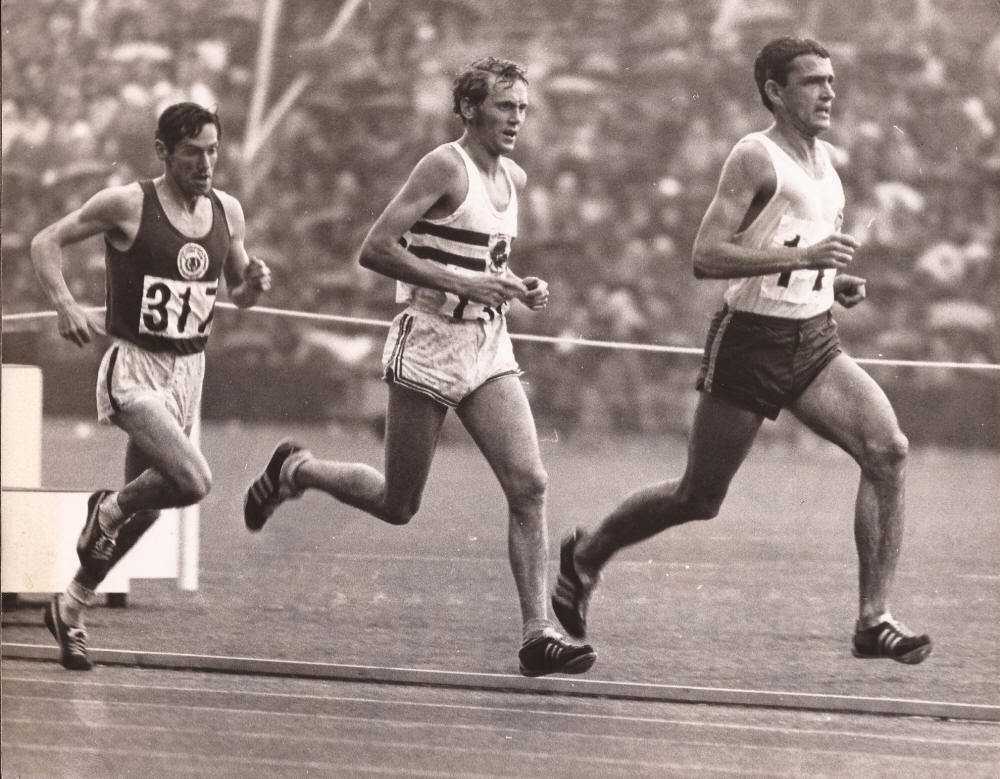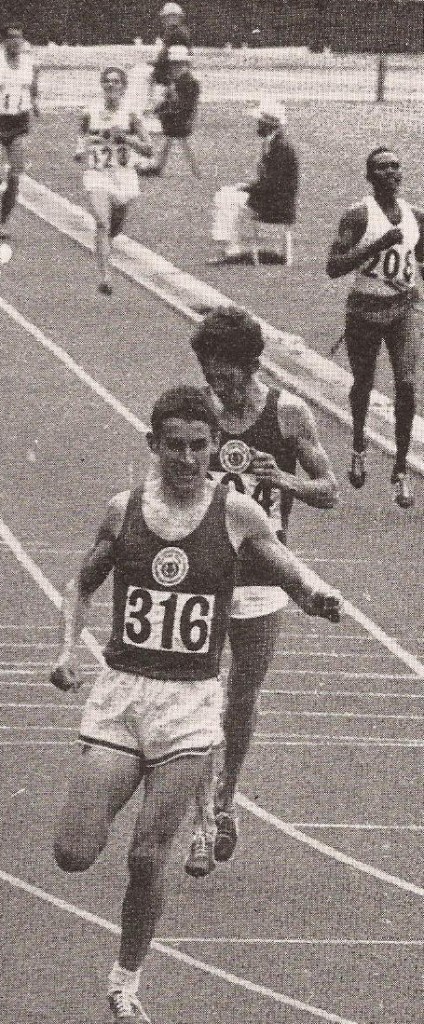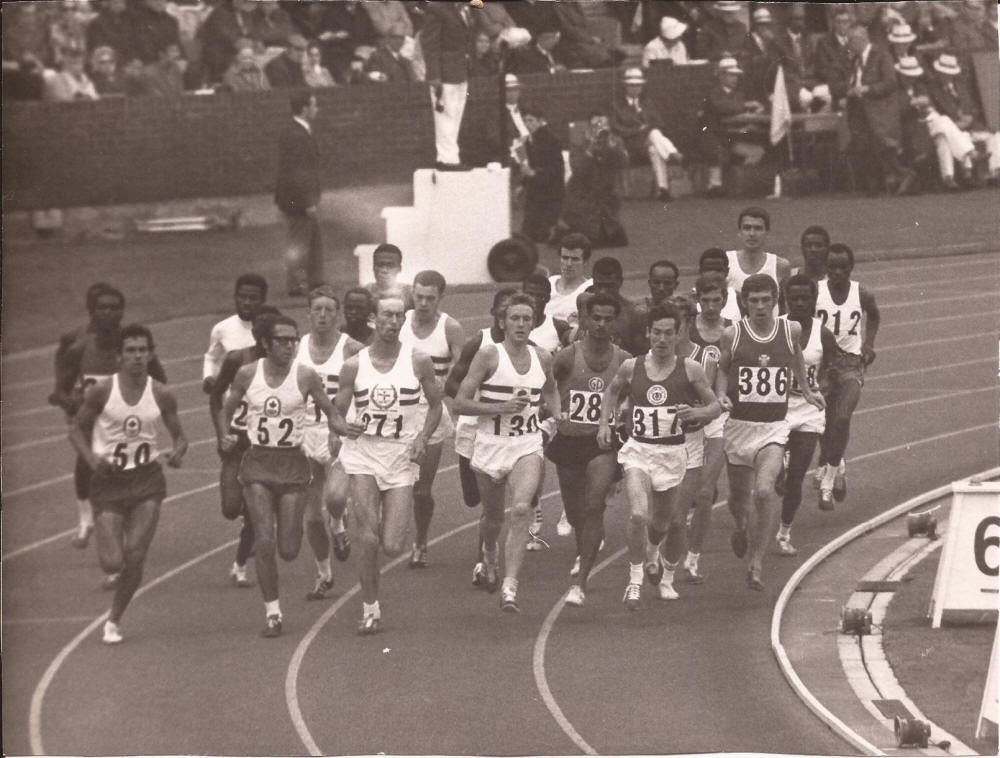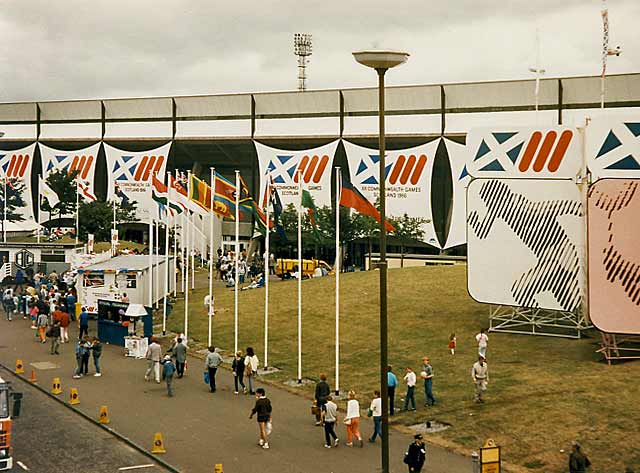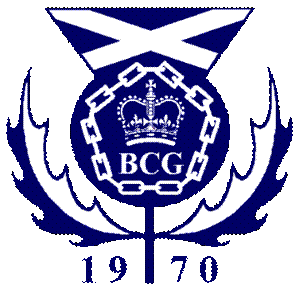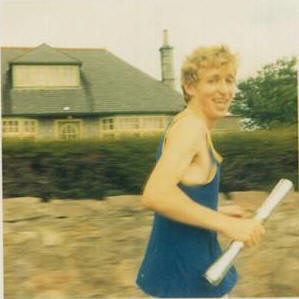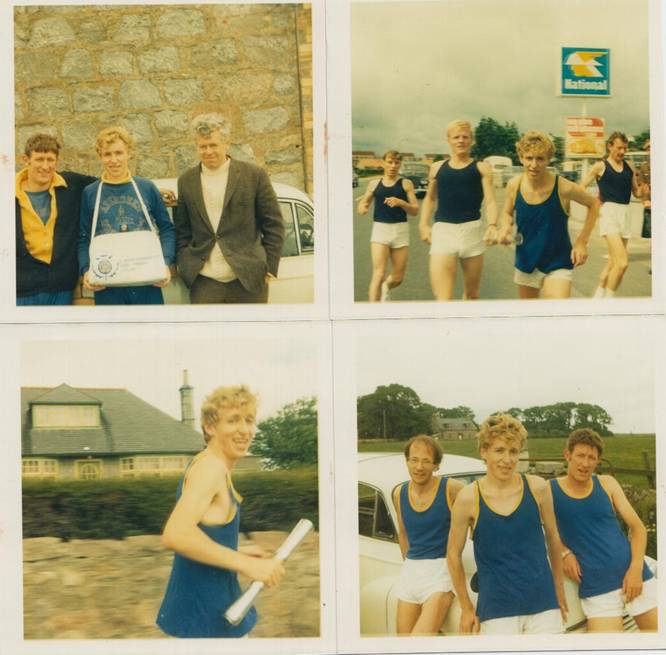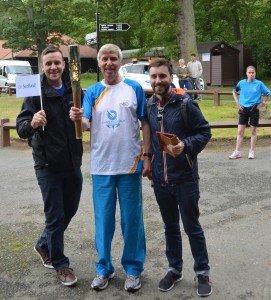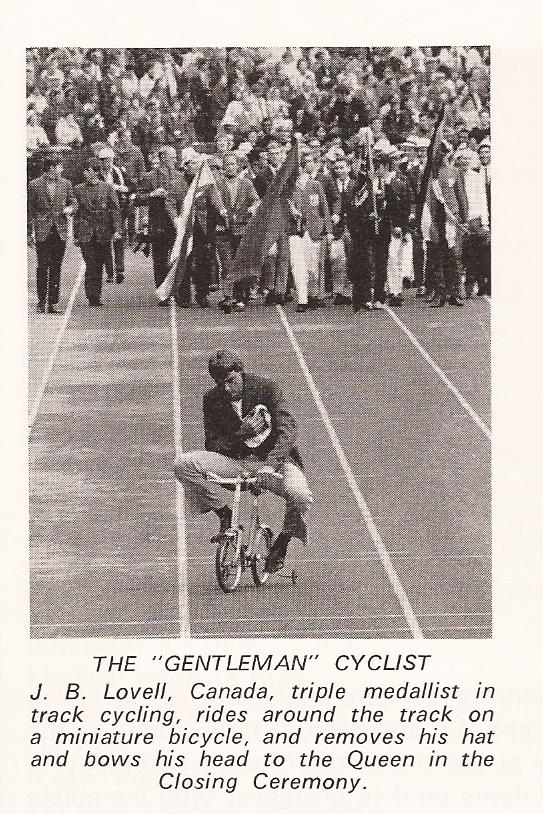
If you ask anyone who was there what their memory of the closing ceremony is, they would without any shadow of a doubt, talk of the “guy in a red blazer on a bike” The teams were supposed to come out in blocks of the competing countries but that soon broke up as the athletes of all sports broke ranks, mixed with each other wand wandered rather than marched round the track, waving at the crowd, taking pictures, blethering to each other and with this huge chap on a tiny trike pedalling along the track and doffing his hat as he cycled past the Royal Box. The Opening Ceremony had gone off like clockwork and the organisers had planned for the closing ceremony to have the athletes enter in sports groups – all the athletes together, all the swimmers, etc – led by placard bearers identifying the various groups. However, the Official Report said: “CLOSING CEREMONY. After the Ceremony of the Flags, it was evident that the remainder of the proceedings will follow the whim of the competitors irrespective of what has been planned by the organisers. The march-in of competitors grouped in the nine sports was an experiment which did not quite come off, although the spirit and friendliness generated as tremendous, it can fairly be said that a good time was had by all.” Even the hearts of the organisers were melted!
If you want to show children or anyone else for that matter the joy of sport, this is your video clip. Winners, losers, officials, administrators, coaches and even the spectators felt part of something very special. I have a couple of stories of the Games to illustrate why it was at this Games in particular that the Commonwealth Games became ‘the Friendly Games’.
First there’s Willie Robertson, a very well known Highland Games ‘heavy’ athlete. He talks about the Kinlochleven Highland Games in 1970. After deciding to go and throw at these Games he came to the conclusion that it would be good to do some walking in the Highlands at the same time. So he set off up the West Highland Way and recalls what happened as follows: “Great weather, made good progress. I camped at the top of Glencoe and I was flooded out during the night. It rained non-stop for three days. I was forced to take bed and breakfast in Kinlochleven and abandon the tent. Day of the Games, it was still raining. Realised the whole trip was a mistake. Then along came a coach with a large part of the Australian track and field team in it. They were a great set of lads. A couple took part in the heavy events. Their chaperon was John Anderson. Had a great time and cadged a lift home. The coach passed my home village of Kirkliston.”
And there you have it. A great coach as a team chaperon: how many international coaches with athletes in the Games would now volunteer to act as a chaperon to a foreign team? How many would stop the bus to pick up a bedraggled Highland Games athlete? Will it happen in 2014?
Charles Bannerman in Inverness recalls the day the Commonwealth came to the Inverness Highland Games. He writes:
“There was an interesting Highland prelude to the 1970 Games when eleven athletics competitors from four Commonwealth countries took part in the Inverness Highland Games on Saturday, 11th July, as part of their preparations for the Meadowbank event. The appearance was negotiated by the North of Scotland AAA officials including the late Donald Duncan, President of the SAAA in 1957.
The squad was managed by former 440 yards world record holder Herb McKenley who was then Jamaican team coach. From Jamaica there were 400m runners Leon Priestley and Eshinan Samuel and high jumpers Yvonne Sanders and Andrea Bruce. The Canadian contingent consisted of endurance athletes Ray Verney, Andy Boychuk and Dave Ellis along with shot putter Brian Caulfield, while reigning Empire and Commonwealth decathlon champion Royal Wiliiams and hammer thrower Warwick Nicoll represented New Zealand.
Completing the eleven strong squad was Scotland’s own 800m specialist Mike Maclean who returned a time of 3:57.2 in the 1500m to defeat Verney. Maclean also returned a surprisingly modest and comfortable 52.8 to win the 400m in which the author, who went on to win that event in the 1976 Inverness Games in an equally modest 52.4, was unplaced.
North distance running legend Alastair Wood moved to the very bottom of his range to take on Canadian opposition in the 5000m where he recorded 14:56 on a grass track whioch had suffered from an extremely wet summer. He eventually conceded defeat to Boychuk and Ellis who crossed the line together in 14:41.
The turf was wet enough for Saunders and Bruce not to risk High jumping but they instead contested the 200m which Saunders won in 25.8.
Nicoll won the wire hammer, the only event of its kind on the North Amateur games circuit at the time, with a throw of 56.29m, nine metres clear of former Scottish internationalist Alex Valentine of Elgin AAC and RNAS LOssiemouth.
However the technical departure to the Scots hammer appears to have got the better of Nicoll who, deprived of the capacity to turn, had to concede defeat to Tony Cohen of Inverness Harriers.
The next day, the NSAAA officials acted as ‘taxi drivers’ to get the athletes back down south where they were due to compete at another meeting over the then customary pre-Games distances of 150, 300 and 600m on the black Rubkor track at Grangemouth.”
That’s just two examples of the unspoiled and spontaneous attitudes of the competitors and home grown athletes. The spontaneity of the ‘heavies’ competing at Kinlochleven when it wasn’t on their itinerary; indeed the issue of stopping and picking up a guy at the roadside is just people behaving normally. Charles’s report on the group of eleven going up to Inverness to compete n the grass is of an incident that is probably inconceivable now. How about inviting a party in 2014 to the Games, Charles???
So far we’ve had comments from Kinlochleven and Inverness about contact with the competitors and officials away from the Games arena, Colin Youngson tells of the Aberdeen involvement in the torch relay. He says,
Instructions were strict. At all times runners must obey Police Officers! White shorts must be worn by all runners and escorts, though club vests may be worn! Girl Guides may wear uniform! On our section we saw neither Police, Escorts nor Girl Guides! The Scottish Association of Boys’ Clubs organised the Relay. Several formal letters were sent out to ensure that it all went smoothly and to thank us afterwards. On Wednesday 15th July, 1970, Aberdeen University Amateur Athletic Club runners were assigned a stretch from Holburn Street at Ruthrieston Roadm past Aberdeen City Boundary to Balquharn Dairy, before Boys Brigade, Sea Cadets and Aberdeen AAC carried on to Montrose, en route for Meadowbank Stadium, Edinburgh on Thursday, 16th July when the Games were to open. We were to take over at precisely 14:16 hours and maintain seven minute miles for five miles. Easy!
Someone took eight photos of our participation. Bob Masson, Ian Hughes (the driver) and I posing in AUAAC gear, displaying a split-new Commonwealth Games kitbag. Taking over from stern-looking runners from a boxing club, Bob, Mike Partridge and I running along, brandishing the beautiful shining silver baton, a streamlined, stylised thistle. Staging a hand-over at walking pace. Me grinning as I dodge up a side-street and pretend to abscond with the baton, unscrew it and steal the Queen’s message. Mike laughing as he watches me disappear off-route. More immature giggling as I pass the baton to him. After the next volunteers took over, the three of us (wearing regulation white shorts) getting our breath back while leaning on Ian’s car. If only all the relay runners had such fun!
Right after that, in time to watch nearly all the athletics, Donald Ritchie and I travelled down from Aberdeen on the train and stayed with a former team-mate at the AU Hare and Hounds Club, Paul Binns and his wife Ceri. They lived in Corstorphine so Donald and I took the bus right across Edinburgh to Meadowbank every day.
I have a first-day cover with the three ‘British Commonwealth Games’ stamps featuring running, swimming and cycling. My cheap camera took only three action photos of the Commonwealth Games athletics: a distant shot of some race; Mike Bull’s winning pole vault, and the joyously chaotic closing ceremony, when athletes of all nations mingled and celebrated together. All the way round the track, spectators could get very close to the action. Tickets were inexpensive and we could often get into the grandstand. I do not remember any officious types or security killjoys.
Every day, fresh programmes in booklet form were on sale. I still have three and must have seen lots of events since the results are handwritten. Most Scottish fans had the same highlights. Lachie Stewart’s victory in the 10000 metres (as the last lap bell rang, I just knew that his famous (only in Scotland!) fast finish would ensure a gold medal for his country, although my heart sank for my hero, Ron Clarke, who had achieved so much throughout his career, but was always to be denied first place in a major championship.) The 5000m: incredible that Kip Keino should be beaten; the wonderful sight of two Scots battling for supremacy (but once again I was secretly supporting the second man, Ian McCafferty- could he not have maintained his sprint rather than, apparently, easing over the line behind the skinhead Anglo-Scot, Ian Stewart, who battled every step of the way to victory?) The marathon: Ron Hill’s string vest ‘miles’in front, setting a European record, topping the 1970 world rankings and probably running the fastest marathon ever over a properly measured course. But what I remember most is the head-shaking exhaustion of our Scottish hero, Jim Alder as he struggled for breath and forced himself round the track to salvage a silver medal, while young Don Faircloth of England swiftly pursued him to finish only 15 seconds behind and win bronze. However, I also possess a copy of ‘Victor’, which was published at the very same time, to read that the winner of the CG Marathon in Edinburgh was actually Alf Tupper, who set a new British record after eating a big bag of chips at half-way!
There were only cheers for every competitor from every corner of the Commonwealth – no insults or booing. It was friendly, enthusiastic and the greatest of occasions for spectators. Athletes who were determined to take part and tried to fight through injury received only support and sympathy. Rainbow memories. Although I have been a spectator at one European Indoor Athletics Championships (1974 in Gothenburg, Sweden) and three International or World Cross-Country Championships held in Scotland (1969, Clydebank; 1978, Glasgow; 2008, Edinburgh), I have never bothered to travel to the Olympics. Too much hassle, better on television; and any way, it could never compare to Edinburgh, 1970! (Mind you, I hope to enjoy Glasgow 2014.)
Thanks for that Colin. With the story of the involvement of the whole community in the torch relay and the possibility of getting good tickets not too expensively, the whole country was actually seriously involved in the event without the excessive hype that spoils so many big athletics events nowadays!
The next contribution is from Graham MacDonald of Pitreavie. He has three good tales which illustrate the friendliness and camaraderie of the occasion – Edinburgh 1970 was where the title of ‘The Friendly Games’ started. Three distinct stories.
1. I was working in the South East at the time of the Games and came up with friends from the club I was with down there, Epsom and Ewell. Two Epsom members were competing in the Games: Barbara Corbett for England (100mH) and Hilary Davies for Wales (100m). At the end of day two (Saturday, 18th July), still walking on air having just seen Lachie win the gold medal at 10000m, we went up to the athletes’ village at Pollock Halls to try to make contact with our Epsom team-mates. We went over to the pub across the road called appropriately “The Gold Medal” – not sure if it’s still called that. I couldn’t believe my luck because there, surrounded by most of the Scottish team, was the man of the moment himself – Lachie – with the gold medal round his neck. I was able to congratulate him personally – a magic moment.
2. Monday 20th July was a rest day for the Games athletics but it was the traditional date for Burntisland Highland Games in Fife. This was an opportunity to take my English friends to see a Scottish Highland Games so off we went. No sooner had we arrived when I recognised the familiar figure of Tom McNab making his way round the track followed by quite a number of the English team wearing their English track suits. Tom was a coach to the English team so he had the same idea and brought them over to see a Highland Games. They sat round the edge of the grass track to watch while I saw Tom going over to the officials table. This was followed by an announcement that there was an additional entrant on the 200m handicap, a Mr T McNab. Tom had persuaded the officials to let him enter.
He had what looked to me like a generous handicap ahead of the field, but after the gun went off, he was overtaken, one by one, by all the other sprinters to the jeers of the English team. Then Tony Wadhams, one of their triple jumpers, decided he would have a go at the caber which was lying just inside the track. He couldn’t get it off the ground – to much cheering from the spectators.
3. On teh Tuesday evening of the Games, 22nd July, I went along to the track in Pitreavie – normal club night – to meet up with my Pitreavie club mates. At that time there were two long jump pits – one along the side of the home straight, the second near the start of the 200m with its runway across the field. From a distance, I could see that there was a girl training on the second runway and even from where I was it was obvious that she was a class athlete. As it turned out, that was an understatement because as I made my way over to the long jump area, I began to recognise her – it was Sheila Sherwood, Olympic LJ Silver Medallist from 1968. I had sat up most of the night during the Mexico Games watching her win that medal and here she was training at Pitreavie!!! I couldn’t believe my eyes and no one else had recognised her. She had wanted to get away from the hullabaloo of the Games in Edinburgh to do some preparation in peace. She was very complimentary about the Pitreavie track. Two days later I watched her win the Commonwealth LJ gold with a jump of 6.73m – a distance which would have won this year’s (2011) UK Championships. I did feel a little bit of pride that she had done some of her final preparation at my home track.
Graham himself was a talented triple jumper who had been injured for a big chunk of the year – Tom McNab was also a triple jumper which was probably why he recognised him at Burntisland! Three nice examples of an age in athletics that seems to be unfortunately gone – but is a time that should never be forgotten. All the stories on this page would have been heart-warming even if the Games themselves had not been of a high standard but add them to the very high-quality performances and it is clear why the 1970 Commonwealth Games were special.
There was one poster on the Unofficial SAL website who recounted that as a dancer in the opening ceremony, she had a pass for the athletes village and remembers playing table tennis with the Kenyans, and even partnering Kip Keino to make up a doubles team. Again the wonderful atmosphere was reported – everyone that you talk to about the Games starts with a smile and talks about the informality and sociability of the event as much as about the sports – which were in themselves outstanding.
